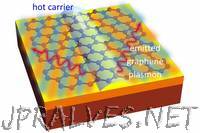
“When an airplane begins to move faster than the speed of sound, it creates a shockwave that produces a well-known “boom” of sound. Now, researchers at MIT and elsewhere have discovered a similar process in a sheet of graphene, in which a flow of electric current can, under certain circumstances, exceed the speed of slowed-down light and produce a kind of optical “boom”: an intense, focused beam of light. This entirely new way of converting electricity into visible radiation is highly controllable, fast, and efficient, the researchers say, and could lead to a wide variety of new applications. The work is reported today in the journal Nature Communications, in a paper by two MIT professors — Marin Soljačić, professor of physics; and John Joannopoulos, the Francis Wright Davis Professor of physics — as well as postdoc Ido Kaminer, and six others in Israel, Croatia, and Singapore.”
